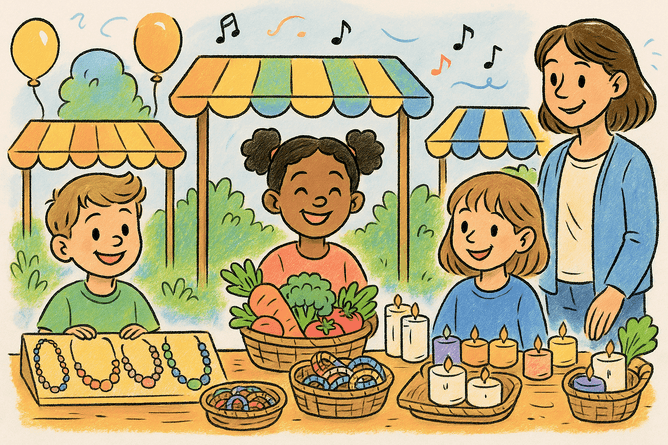There’s something special about a market run for kids, by kids. From the excited chatter at their stalls to the proud smiles after making their first sale, kids markets are far more than just a fun day out — they are powerful tools for community connection, learning, and child development.
Running a kids market creates an uplifting, supportive environment where tamariki can showcase their talents, explore entrepreneurship, and grow in confidence. But the impact goes beyond the individual — it ripples through whānau, schools, and the wider community in meaningful and lasting ways.
1. Building Confidence in a Child-Focused Space
Kids markets provide a platform where tamariki can take the lead. Whether they’re selling homemade crafts, baked treats, plants, or secondhand treasures, the experience of setting up their own stall helps build self-esteem and independence.
In a setting designed specifically for them, children feel safe to try new things, speak to customers, and manage small tasks like pricing and giving change. These seemingly simple moments are huge for confidence-building — and they happen in a way that feels natural and empowering.
2. Real-Life Learning in Action
A kids market transforms learning into something hands-on and memorable. Children apply maths by counting money and tracking sales, practice literacy by designing signs or product descriptions, and develop communication skills by talking to customers.
They also learn resilience — sometimes they don’t make as many sales as they hoped, but they gain experience, reflect, and come back stronger next time. These are real-world lessons many adults wish they had learned earlier!
3. Strengthening Whānau and Community Ties
When tamariki set up their market stalls, it brings families and communities together in a way that’s positive, supportive, and proud. Parents, caregivers, and kaiako (teachers) rally around to help with preparation, and community members come along to support the kaupapa.
This shared experience builds stronger relationships. Everyone plays a role in helping children grow and succeed — and the pride is felt by all.
4. Encouraging a Spirit of Collaboration Over Competition
Kids markets often foster collaboration rather than competition. Tamariki help each other set up stalls, share resources, and even combine products or ideas. It’s not about being the “best” business — it’s about being part of something.
This spirit of inclusion and teamwork creates a nurturing environment where every child can feel seen and valued, regardless of what they’re selling or how many sales they make.
5. Highlighting the Talents and Passions of Our Tamariki
Many children surprise their whānau and community with the creativity and passion they bring to their stalls. Whether it's handmade jewellery, eco-friendly soaps, custom art, or clever recycled crafts — kids markets show us just how capable and innovative our tamariki truly are when given the chance.
It also allows them to explore their interests and see what lights them up. For some, it might even spark a lifelong passion or career path.
6. Creating a Ripple Effect of Inspiration
Kids markets have a lasting impact. When one child sees another running a stall with confidence, they think, “I could do that too!” It sets off a ripple effect, inspiring others to have a go, dream big, and back themselves.
And when communities see the value in these events — not just in economic terms, but in social and educational outcomes — they’re more likely to keep investing in the success of their young people.
Conclusion: A Market Full of Potential
Running a kids market is about so much more than sales and stalls. It’s about building a child-focused environment where tamariki can express themselves, connect with others, and realise just how much they’re capable of.
It uplifts communities, strengthens families, and creates the kind of positive, inclusive space we all want to be part of.
Because when kids are given the opportunity to shine — they do. And we all benefit from the light.

